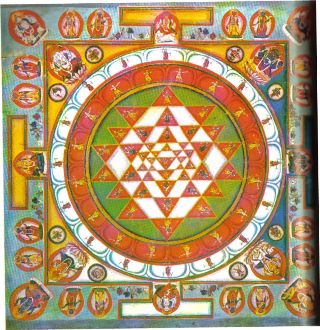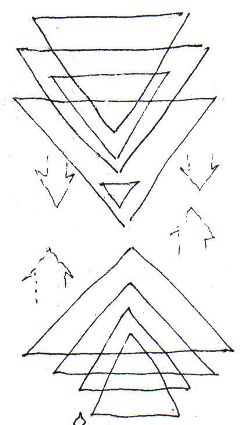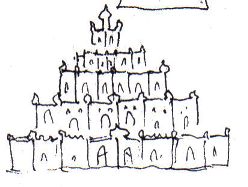THE SRI YANTRA AS A SYMBOL FOR CONTEMPLATION
Adam Blatner
December 12, 2008

|
Yoga is the practice of seeking mystical connectedness; there
are many of these and they arise out of both Hindu and Buddhist
traditions. More recently, yoga has become more popular in Western
cultures, especially in the form of the health-promoting body exercises
called hatha yoga.) In addition to body postures, though, as noted,
there are many other ways of spiritual development in yoga, ranging
from chanting specific simple or more complex melodies to contemplating
and drawing certain diagrams to a variety of types of meditation.
One of the more traditional diagrams for contemplation consists
of a pattern of five downward pointing triangles overlapping with four
upward-pointing triangles, this variably being placed in a circle
surrounded by the lotus-petal diagram so common in South Asian art. A
yantra is a visual equivalent of a mantra, a yogic device for
contemplation.
I draw and enjoy geometric constructions and drawings based on
these, especially in the form of mandals (about which I write on
another webpage, and examples also found on other webpages).
Sri (pronounced Shree) is an honorific, meaning especially
sacred, and this yantra has been fun and fascinating for me: Learning
to draw it so that the lines work has been a challenge. If the lines
are too far apart or close together, it doesn’t come off, or it’s too
squinched. I’m getting better at it, but I cannot say I’ve perfected my
technique.
While this yantra has been given a variety of traditional
interpretations, my tendency is to re-think everything, to consider
what an interpretation might be in light of the discoveries of modern
science, and expressive of my current drift in philosophy.
To me, then, the Sri Yantra expresses the peculiar resonances
generated by a variety of multi-dimensional interpenetrations, which
invites us to contemplate both dimensionality and inter-penetration.
Dimensionality
It began with a mathematical way to describe physical space by
assigning the parameters of length, height, and depth to objects. Zero
dimensions is a point, which in fact doesn’t exist. As far as we know,
even the tiniest point has some microscopic length and height, and in
actual life, also depth—even an atom or a sub-atomic particle.
(Actually, neither does one or two dimensions exist in our universe,
but are theoretical constructs, mainly expressed in the two-dimensional
space of a piece of paper.) One dimension is length—expressed as a
straight line. And two dimensions includes also width, which allows the
line to curve, close, form shapes, letters, etc. In fact, these forms
do have width, but of a thinness that is insignificant in our thinking
for most purposes. (Art restoration and some forms of detection that
deal with layers of paint or what might be written in invisible ink
might deal with the matter of thickness of the writing medium on a
surface, but most situations just deal with what is represented on the
surface rather than the physical nature of the representation—the
signified rather than the sign. I have some interest also in the nature
and evolution of signs, letters, alphabets, etc.)
Much of mathematics and scholarship treated the world as if it
followed certain rules according, first, to the geometry described by
Euclid—the geometry of flat (two-dimensional) surfaces. As we became
more aware that this geometry didn’t apply to curved surfaces, geometry
became correspondingly more complex. Einstein found it useful to assign
to time also the concept of dimensionality, as time is involved in the
movement of forms through space, their change, transformation, growth,
development, decline, etc. However, in so doing, Einstein shifted the
meaning of the term “dimension” a bit—and that shift is significant! It
invites us to re-think dimension not simply as an aspect of physical
space, but as a category that interacts with all other categories.
In my thinking, that re-definition offers a solution to a
traditional conundrum: How can mind, which seems different in basic
quality from matter, yet coexist with matter? My answer is that mind is
simply another dimension, one that interpenetrates with all matter. A
corollary is that there is no matter without some degree of mind,
feeling, experience. (There is an extensive argument for this that has
been developed by Alfred North Whitehead and before him, also other
“process” philosophers—and since Whitehead, also. I am sympathetic with
this approach, which shifts our perspective from looking at the world
in terms of things moving to events happening— the latter then being
analyzed by Whitehead as having their own unfolding dynamics,
undercutting the illusion that there ever was or can be mere
“thing-ness.” It’s sort of analogous to recognizing that neither can
there be mere space without time.)
All this lays the foundation for another mystery: What is
spirit, enlivenment, or the apparent gradient of consciousness ranging
from sleep to awakeness, and from ignorance to insight? Can humanity
and wisdom evolve and become more conscious? I am biased towards this
being likely, and am interested in promoting the process, however
modestly, in our own time.
Meanings
This brings us back to the Sri Yantra. It is a symbol or a crude map of what I think is going on:

|
First, let us consider the four upward-pointing triangles,
which express what science admits is basic to our existence, the
ground of our being. And yet this is true also of stars and rocks.
– matter, the sheer density, inertia, stability,
as well as its aggregate power (in the form of gravity) or force (when matter moves
through time)
– space, the matrix of existence
– time, another dimension of that matrix
– energy, the sheer interplay of these components
Now, what makes this foundation alive, in a sense, and
even interesting, is the way the spiritual principles descend,
inter-penetrate, and enliven these basic dimensions. So the five
downward-pointing triangles represent (at first hunch, and from the
largest to the smallest):
– complexification, the draw toward new properties emerging at
each new level of complexity (with an emphasis on mind itself becoming
more complex, collective, and multileveled or organismic)
– differentiation, the formation of subtypes, permutations,
species, along with the way the archetypes or potentials converge as a
nexus to form an individual
– vibration, the dynamic pulse within time
– mind, the essence of subjectivity
– spirit, the essence of impulse of becoming
These interact, enliven existence, rippling outward, all
operating at once. They generate stars, complex and larger stars,
somewhat analogous to the many chakras or centers of consciousness that
are expressed within the psyche and also along the spine in another
type of yoga—kundalini yoga.
Now, I’m not fixed on this scheme: it is provisional, but
evocative in my imagination. How do the various principles play off
each other? For one thing, each interpenetration generates ripples,
more widespread dimensions and closer-in dimensions.
For example, we have the individual’s body as an inner core,
the ego or accumulation of roles and learning around it; the person’s
interpersonal relations as another layer, and broader group
affiliations as a wider layer, reaching out and being influenced by and
in turn contributing to and co-creating the yet wider culture.
- - - -

|
Below is a drawing that suggests the way the parts could fit inside each other.

|
And to the right is a drawing that suggests that put together, this more 3-D figure would be a kind of step pyramid or castle.
- - - - -
This may seem to be a weird way to think, but it is closer to
the way mathematicians ponder geometrical forms or scientists think
about unusual findings registered in a test instrument — whether it be
an oscilloscope, telescope, microscope, spectroscope, etc. The
game is to imagine that a finding means something. It’s not just a
random blip. Especially when it shows up repeatedly under certain
circumstances. So what does it mean? Enter theory-building.
The Sri Yantra works in my mind at several levels. When I draw
it, it serves as a centering mandala, it expresses a kind of order
within the welter of ambiguities of this world, as if to suggest that,
yes, there is a kind of map: It is a map inward, through layers of your
own mind, past the particulars, to attend to the more essential
dynamics.
Here's some more play with this:
This pattern was featured as a metaphysical
force-field generated by toys sent from a future civilization in the
2006 motion picture, "The Last Mimzy"
from New Line Cinema (now available on DVD). (The children's
capacity to understand these forces allows them to save the world.)
This Sri Yantra mandala is used in the movie as a portal for time
travel. (This information from Discovery magazine, December 2007 issue,
pg. 70.)
Here are some questions:
1. What is the smallest number of overlapping triangles you must draw to make the Sri Yantra?
2. The red sybmolizes the feminine, and the
white symbolizes the masculine. How many red shapes are there? How many
white shapes? How many triangles of any size are there altogether?
Include triangles that are composed of both red and white shapes.
(Answers at end)
More to be added in time.
For more about the Sri Yantra, see comments in middle of lecture on mandalas as an aid to understanding "deep maturity."
Answers: 1. To draw the Sri Yantra you must draw nine triangles, 4 pointing up and 5 pointing down.
2. There are 43 red shapes and 31 white shapes.
3. There are 120 triangles of all sizes altogether, 50 pointing up and 61 pointing down.